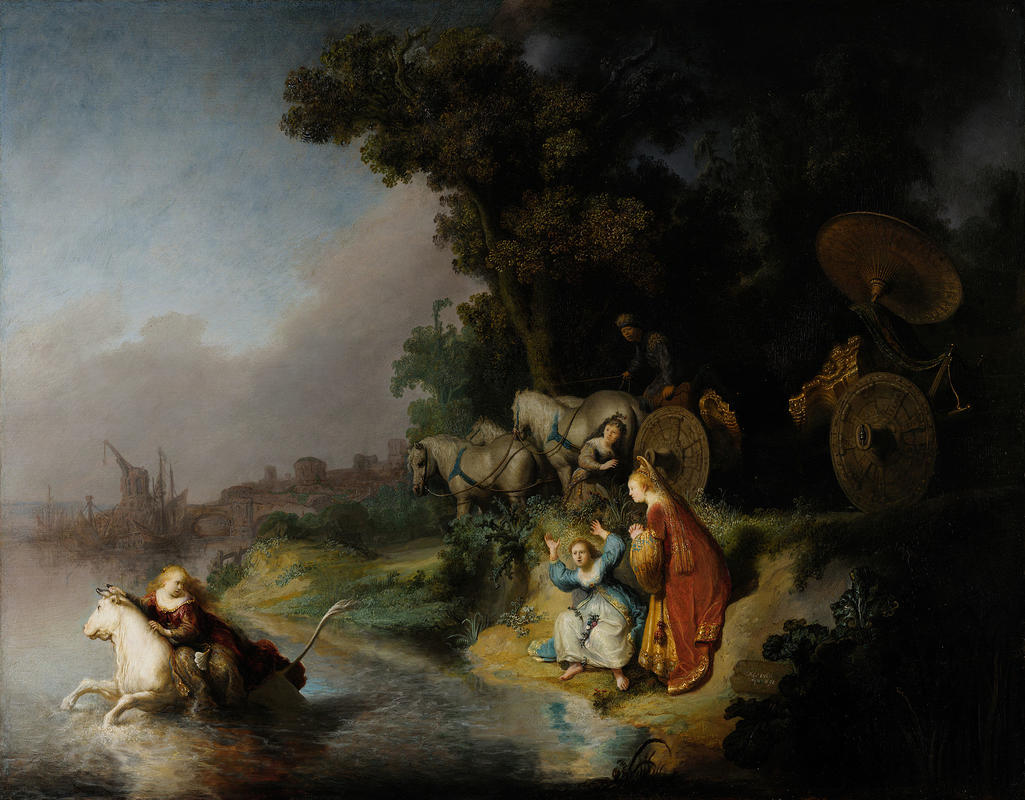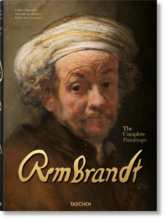More about The Abduction of Europa
- All
- Info
- Shop

Contributor
The Abduction of Europa is the love story you never knew you wanted— nothing screams “romantic getaway” like being dragged from the shore by a horny god in bull form!
Step aside, The Kiss. There’s a new grippingly romantic painting in town.
I kid. Europa looks vaguely alarmed, an underwhelming reaction from a kidnappee being forced into the water by an eerily motivated bull. Considering the dire circumstances, Europa is entirely too put together. More importantly, why isn’t she making a dive for it? If a bull can run through this water, you can bet Europa could swim through it— even in the uncomfortable finery of the 1600s.
Rembrandt based this disturbing scene on Metamorphoses, an Ancient Roman reinterpretation of Greek mythology. Legend has it Zeus, captivated by the princess Europa’s beauty, appeared before her as a white bull to wrest her from her homeland. Just when the princess’s companions got cozy, weaving flower crowns for their new bovine friend, Zeus revealed his true colors. He wrenched Europa from the shore and together they crossed the ocean to Crete. Considering the loss of homeland and terrifying transportation, the very least Europa could get was a continent named after her. After that ordeal, she deserved the whole galaxy.
Gratuitous animal transformation? Olympians who haven’t heard of consent? Useless onlookers who don’t even try to grab their panicked friend? Check, check, and check. All in all, this is one of Zeus’ creepier conquests. And that’s saying something from a guy who swallowed a lover, then birthed an adult daughter out of his skull. No wonder the creepy tale fascinates painters; this scene has been interpreted by greats like Goya, Gauguin, and Titian.
Rembrandt differentiated himself from his colleagues with an anachronistic medley of Greek mythology and contemporary setting. In the distance, a crane is visible, along with an industrial city reminiscent of Amsterdam. The figures wear the clothing of Rembrandt’s day.
Oddly enough, Europa was neither the first nor the last of her line whose life was changed by a white bovine. Her ancestor Io, another of Zeus’ conquests, was turned into a white cow to hide her from a jealous Hera. Europa’s own son, King Minos, refused to sacrifice a promised white bull to Poseidon. Poseidon’s twisted vengeance was a curse upon Minos’ wife, making her thoroughly infatuated with the same bull. If I were in this family, the moment I heard so much as a “moo” I’d head for the hills.
What can we learn from this troubling tableau? Seduction should involve charm, respect, and wit. Avoid showing up as an aggressively large mammal and dragging the object of your affections from her friends. If you have to shape-shift to get a significant other, it’s not consent.
Sources
- “The Abduction of Europa.” The J. Paul Getty Museum. Accessed June 27, 2017. http://www.getty.edu/art/collection/objects/882/rembrandt-harmensz-van-….
- “The Abduction of Europa 1716.” National Gallery of Art. Accessed June 27, 2017. https://www.nga.gov/content/ngaweb/Collection/art-object-page.154233.ht….
- “The Abduction of Europa (Rembrandt).” Wikipedia. October 20, 2016. Accessed June 27, 2017. https://en.wikipedia.org/wiki/The_Abduction_of_Europa_(Rembrandt).
- “Europa (Mythology).” Wikipedia. June 8, 2017. Accessed June 27, 2017. https://en.wikipedia.org/wiki/Europa_(mythology).
- “Io.” Encyclopedia Britannica. November 8, 2007. Accessed June 27, 2017. https://www.britannica.com/topic/Io-Greek-mythology.
- “Metis (mythology).” Wikipedia. June 24, 2017. Accessed June 27, 2017. https://en.wikipedia.org/wiki/Metis_(mythology).
- “Minotaur.” Wikipedia. June 24, 2017. Accessed June 27, 2017. https://en.wikipedia.org/wiki/Minotaur.
Featured Content
Here is what Wikipedia says about The Abduction of Europa (Rembrandt)
Rembrandt Harmenszoon van Rijn's The Abduction of Europa (1632) is one of his rare mythological subject paintings. The work is oil on a single oak panel and now located in the J. Paul Getty Museum. The inspiration for the painting is Ovid's Metamorphoses, part of which tells the tale of Zeus's seduction and capture of Europa. The painting shows a coastal scene with Europa being carried away in rough waters by a bull while her friends remain on shore with expressions of horror. Rembrandt combined his knowledge of classical literature with the interests of the patron in order to create this allegorical work. The use of an ancient myth to impart a contemporary thought and his portrayal of the scene using the High Baroque style are two strong aspects of the work.
Check out the full Wikipedia article about The Abduction of Europa (Rembrandt)













